5 Questions with Janet Voight and Peggy Macnamara, authors of “From the Seashore to the Seafloor: An Illustrated Tour of Sandy Beaches, Kelp Forests, Coral Reefs, and Life in the Ocean’s Depths”

Have you ever walked along the beach and wondered what kind of creatures can be found beneath the waves? We can find the answers in From the Seashore to the Seafloor, an exciting collaboration between a renowned scientist and a leading scientific illustrator. With brilliant artwork and accessible scientific descriptions, Janet Voight and Peggy Macnamara introduce us to the animals that inhabit the ocean—from beaches to coral reefs to the ocean’s depths. We spoke with Peggy and Janet about their new book, future projects, and more.
Peggy and Janet, can you tell us about how this collaboration come to be?
PM: I always admired Janet’s work so one day I asked if she would like to collaborate.
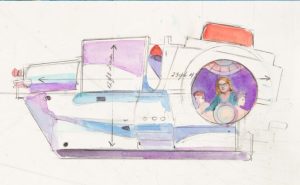
JV: It is all Peggy’s fault. She had been after me for years to write a book, something I never wanted to do (as in me? Write a book?!) She finally wore me down, promising it would only be a short book. I asked what I should write about. “The Oceans,” she said. Duh! In a short book! The oceans cover nearly 70% of the planet, have an average depth of 3720 m (2.3 miles), and are home to the highest animal diversity on Earth. Although I have been studying marine animals for decades, I feel that I know precious little about their home. I was still shaking my head over this days later. When my brother announced he had an upcoming trip, I complained that I never went anywhere. He reminded me that I get to go to all sorts of places! That was the seed for the book: ocean places I’ve visited that have had a special impact on me.
Janet, you’ve taken twenty-two research trips to study ocean life—including eight trips on the submersible Alvin, which dives almost 15,000 feet below the water’s surface. What have you learned about the ocean that would be surprising to most readers?
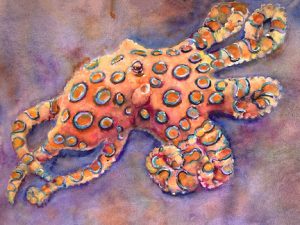
JV: I think the Deep Scattering Layer is the most visually stunning and counter-intuitive, and we hope the chapter in the book encourages readers to learn more about it. When Alvin passes through this depth zone, animals all seem to show off their bioluminescence. It is so amazing; there are different shaped lights, which you have to figure means different animals. Yet this is fairly deep, maybe 900 m (just under 3000 ft) below the sea. What do these animals eat? The answer is that at night they all sneak up to the shallow water where food is plentiful! And at daylight, they sink into the depths.
Peggy, you’ve collaborated with other scientists in the past for books such as The Peregrine Returns and The Art of Migration, which focus on birds and insects. What challenges did you face in illustrating marine life?
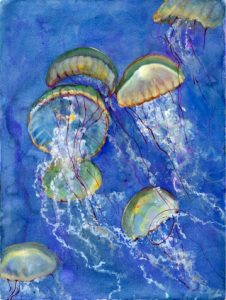
PM: Marine life images often appear in a bioluminescence atmosphere. This was new for me. Birds and bugs are mostly in the open air, a common habitat. I found that the darkness surrounding a subject gave each painting more weight. The creatures were unfamiliar and unique. . . . I wish I had painted more!
How did you wind up in your fields, and what do you love about your work?
PM: I ended up drawing every day at the Field Museum long before my subject became nature. I began in the Chinese exhibit on the east balcony. I spent ten years delighting in the manmade treasures and the classical architecture that surrounded each case. I eventually moved into birds to learn more. My subjects were full of surprises, like unusual color and composition. They taught me to be a better artist, what to look for, and how to see more accurately. With this work, I have the chance to contribute to “The Love of Science” and to educate a broader audience on the earth’s creatures that we should be preserving.
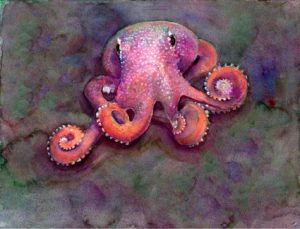
About 25 years ago I was asked by a scientist, Debby Moskovitz, to paint some new plant species found in Peru. What an honor it was to contribute to the work of conservation. She was able to use my paintings when trying to convince the government to preserve an area. I’ve taken every opportunity since then to try and contribute. The books hopefully give readers a chance to think about how they might contribute.
JV: I alternate between thinking I must have been lucky, and that I must have used every available opportunity. I think to be a scientist, one must make one’s own luck. I had a hiatus after college before I started graduate school, and in that time, I realized that I missed learning things. An undergraduate internship allowed me to pursue research which I really enjoyed and, it turned out, I seemed to be good at. When I started grad school, I thought I would study land-based systems, but I did not feel a spark. When I started studying octopus, it seemed that everything fell into place. I was drawn to the deep sea because it offers discovery. That is what I love best about science.
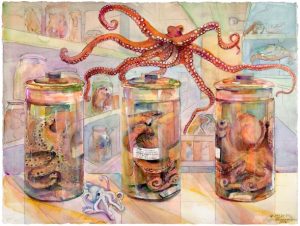
What projects do you have coming up next?
PM: I have done six paintings from an Antarctic adventure that John Bates (also of the Field Museum) went on last January with five female scientists. It was an amazing opportunity to explore Antarctica through the eyes of these scientists.
JV: Scientific papers on wood-boring bivalves!

Janet Voight is the Women’s Board Associate Curator for Invertebrate Zoology at the Field Museum of Natural History in Chicago. Peggy Macnamara is an artist-in-residence at the Field Museum and an adjunct associate professor at the School of the Art Institute of Chicago.
From the Seashore to the Seafloor is available now! Find it on our website, online at any major booksellers, or at your local bookstore.